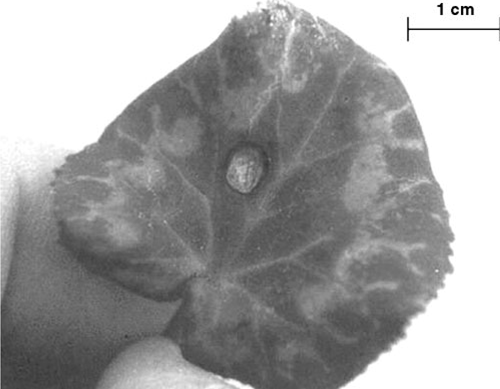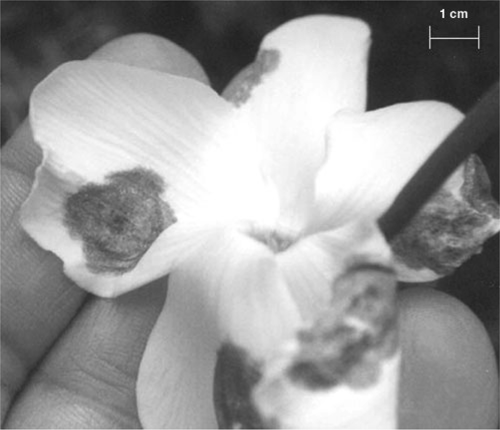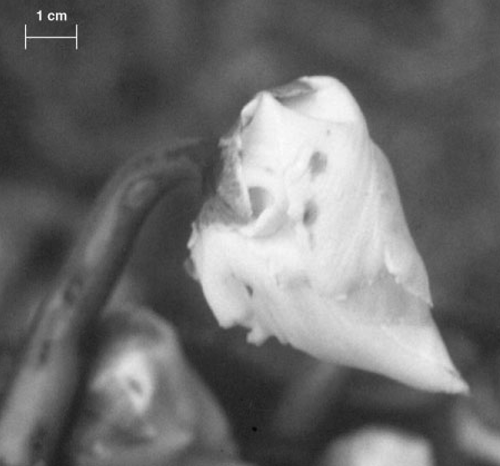Florist’s cyclamen anthracnose caused by Colletotrichum gloeosporioides in Argentina
E. R. Wright A B , M. C. Rivera A , A. Mascarini A , L. S. Nuñez A and C. M. Gentile AA Faculty of Agronomy, University of Buenos Aires, Av. San Martín 4453 (1419), Ciudad de Buenos Aires, Argentina.
B Corresponding author. Email: wright@agro.uba.ar
Australasian Plant Disease Notes 1(1) 1-2 https://doi.org/10.1071/DN06001
Accepted: 23 September 2005 Published: 24 August 2006
Abstract
Anthracnose caused by Colletotrichum gloeosporioides is reported for the first time on Florist’s cyclamen in Argentina.
Cyclamen persicum Mill. (Florist’s cyclamen; Primulaceae) is an herbaceous perennial. Leaves are cordate-shaped, with variable green and silver patterns, basally attached to a corm-like structure. The leaf petiole and flower scapes can be up to 20 cm long. Flowers vary in scent and colour (Dole and Wikins 1999). Florist’s cyclamen is among the most economically important flowering crops in Argentina. Cyclamens are cultivated for more than 50% of pot plant growers in Buenos Aires (Morisigue et al. 2002). Between June and July 2001 a new disease was observed on cv. Mini in experimental greenhouses in Buenos Aires city and in crops in Pablo Nogués, Moreno and Loma Hermosa (provinces of Buenos Aires), after unusually humid conditions. Symptoms consisted of extensive lesions on aerial organs. Rounded, irregular dark brown spots of 2–18 mm diam. developed on leaves and petals, often coalescent and with dark acervuli within. Leaf spots were surrounded by a purple halo (Fig. 1). Lesions on petals usually initiated on the margins (Fig. 2). The necrotic centres of leaf lesions fell out in many mature leaf symptoms. Spots of 4 × 2 mm were observed on flower buds, peduncles and petioles (Fig. 3). Incidence varied from 50–80% and caused important losses in marketable plants.

|

|

|
Pieces of 1 cm2 of infected tissues were dipped in 70% ethanol for 1 min and 0.2% NaOCl for 1 min, washed in sterilised tap water and blotted dry. The material was incubated on 2% potato dextrose agar at 20 ± 2°C.
Inoculation for pathogenicity tests was done by spraying a conidial suspension (4 × 106 conidia/mL) onto 20 healthy cyclamen plants cv. Mini. Aerial tissues of half of the plants were wounded with sterile needles. Wounded and unwounded control plants were sprayed with sterilised water. Plants were incubated in plastic bags at 22 ± 2°C with a 12 h photoperiod for 72 h, and remained under the same environmental conditions after the bags were removed.
White colonies developed after 4 days and turned grey with age. The reverse of the colony was grey. Aseptate, colourless, straight cylindrical conidia measured 18(15–19) × 4(3.3–5) μm. Conidial masses were salmon-coloured. The isolate was identified as Colletotrichum gloeosporioides (Penz.) Penz. and Sacc. in Penz (Bailey and Jeger 1992). The teleomorph stage was not observed.
Symptoms developed from the fifth day, on unwounded and wounded plants. Controls remained symptomless. The pathogen was reisolated from symptomatic tissues, thus completing Koch’s postulates. To our knowledge, this is the first report of C. gloeosporioides on C. persicum in Argentina. A culture of the pathogen has been lodged in the Culture Collection of the Department of Plant Pathology, Faculty of Agronomy, University of Buenos Aires, as CC1. This fungus is able to cause disease on vegetative and reproductive organs, thus affecting the plants marketability. No damage was needed for pathogen penetration in cyclamen tissues. Further studies are needed to determine the response of local isolates to different environmental conditions as well as possible differential cultivar performances.


